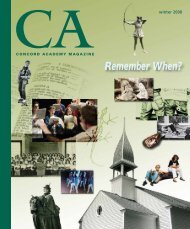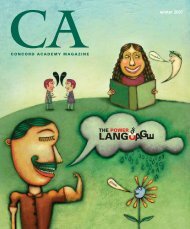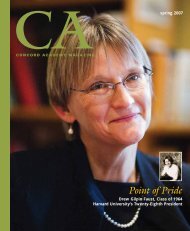CAMPUS
Meet Rick Hardy - Concord Academy
Meet Rick Hardy - Concord Academy
You also want an ePaper? Increase the reach of your titles
YUMPU automatically turns print PDFs into web optimized ePapers that Google loves.
Spa Digital‘hola!’ and generally seeing the idea of being from another culture asinteresting and cool and special.”Johnson said her role as parent to her daughter Louisa had“almost everything to do with” her creative vision. “I was alwaysinterested in media,” she said. “But when Louisa was very youngand I saw the way her brain was developing and how the synapseswere being created, questions about brain development and how kidsmake connections really inspired me.”In the twenty-one years since Johnson began at Nickelodeon,her daughter has grown up, and so has children’s media. “One of thebiggest changes I’ve seen is just how much great educational TV isnow available for kids,” she said. “And the use of computers is a bigchange as well. Parents now speak of computers as an educationaltool for their children.”What has not changed much is what’s required to create qualitychildren’s television. “Certainly, classic delivery systems of TVhave been transformed radically in the past few years, but the basicsof the creative process haven’t changed,” Johnson said. “There continuesto be a lot of demand for great stories, wonderful characters,and learning opportunities for kids.”Brown Johnson ’70, above; Blue the dog from Blue’s Clues,below; Dora the Explorer, leftusing television in a brand new way to educate and include kids inthe learning process,” Johnson said.Dora the Explorer is a world awayfrom the Disney princess. Sturdily builtand attired in shorts and a T-shirt, Dorais a bilingual Latina heroine whoromps through the world with a hostof animal friends, her vocabularysprinkled with Spanish phrases thatviewers are encouraged to repeat.Johnson got the idea for Dora in thelate nineties, during a Children Nowdiversity conference that focused onthe underrepresentation of minoritycharacters across all forms ofmedia. Several speakers therepointed out that there were nononwhite children in lead roleson any series for preschoolers.Johnson began to imagine achild who would not only havedarker skin than most TV characters,but who would also make bilingualismand multiculturalism seem likesomething to celebrate.When soccer-playing Dora first appeared, calling her parents“Mami” and “Papi” and shouting “Vamanos!” to her friends, Johnsonbraced for the backlash. “We were ready for parents to call ussaying, ‘We’re in America; why do you have characters speakingSpanish?’” she said. “Instead, we immediately heard from parentswho thought it was great that their kids were using expressions like11W W W . C O N C O R D A C A D E M Y. O R G F A L L 2 0 0 9











